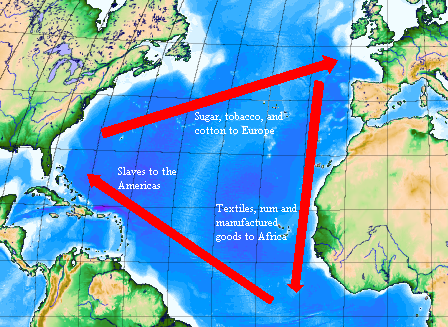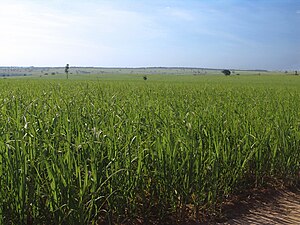Topic 4.4 Maritime Empires Established
The profits earned by Vasco da Gama's first voyage to the Indian Ocean was not lost on other European kingdoms. Over time, profits only increased; seventy-seven years after da Gama's trip, Sir Francis Drake's cargo of spices earned his English investors a return of 4,700 percent.[1] Motivated by the allurement of enormous profit, the Portuguese and Spanish, followed by the English and Dutch, sought to build sea-based empires (maritime empires) and make fortunes from these newly discovered sources of wealth.
As the first European power to journey into the Indian Ocean, the Portuguese immediately set out to build an empire and exploit this region for its own benefit. From the start, superior firepower allowed them to accomplish much. The Portuguese stormed the Swahili city of Kilwa and threw out its Muslim leaders. Commander Alfonso Alboquerque seized Malacca in 1511 (the Dutch would take it from Portugal in 1641). The Portuguese attempted to close the Red Sea to trade to stop this "leak" of profit through their fingers into the Mediterranean via Egypt. Breaking traditional customs of tolerance, the King of Portugal asked the leader of Calicut to expel all Muslims from his kingdom.
According
to the long standing conventions of Indian Ocean trade, no single power controlled the entire network and the seas were free and open to any merchant. The Europeans would attempt to change this. Beginning with the Portuguese, Europeans attempted to install a Mediterranean system of trade which used military might to divert trade through trading ports they controlled. There it could be taxed. [2] They did not really bring any items of their own to trade, or add value to the sum of trade in this region. Instead, they attempted, in a parasitic way, to extract benefits from the host network into which they forced themselves.
They also required merchants to purchase passports from them; sailors caught at sea without one were mutilated and had their cargo confiscated. Despite these grand plans, the Portuguese had neither the manpower nor the fleet to carry out its ambitions. Many Indian Ocean merchants took their chances and sailed without passports or paying dues at Portuguese trading-posts. And the Spanish, English and Dutch sailors hired by the Portuguese to work their fleets took the knowledge of the seas back to their respective countries who were organizing their own expeditions to Asia. [3] Rather than an all-out conquest of the region, they established a trading-post empire in order to profit from goods as they moved from one area to another. By the end of the 1500s they had integrated with the normal political and economic climate of the region. [4]
Other European countries would implement the same strategy. The Dutch, for example, found that working within the existing system could produce for them the highest profits. They made a fortune charging fees to transport items from one Asian area to another. [5] The European powers were never able to establish genuine and lasting monopolies in the Indian Ocean. This is in stark contrast with their experiences in the New World.
- B. We saw in the previous period (600-1450) that the creation of a common currency in China facilitated trade in that region. Widely accepted currencies speed up transactions and provide standardized way for merchants to measure the value of products. In this period the use of a common currency expanded from regional to global use. The Spanish peso de ocho, or "piece of eight," was the first currency in history to be used globally.
- This currency was the product of Spain's mining of enormous amounts of silver in the New World. In present day Bolivia and Mexico, they discovered massive deposits of silver, including a mountain full of silver at Potosi. After the purest veins of silver were quickly strip-mined production slowed; then the Spanish introduced the amalgamation method of using mercury to extract silver from ore. Production soared. In two centuries the silver mines of the Spanish New World produced 40,000 tons of silver. [6] The industrial centers that grew around these mines minted 2.5 million silver coins per year. The peso de ocho, worth about 80 US dollars today, gained acceptance around the world and lubricated global trade on an unprecedented level. Mughal India wanted Spanish silver for payment for its pepper sales, and this surge of silver funded Shah Jahan's construction of the Taj Mahal. Much of the Spanish silver ended up the hands of the Chinese, who had no desire for European products but readily accepted silver as payment for its coveted exports. The peso do ocho was even accepted currency in the United States until the Coinage Act of 1857. [7]
- C. In the early 1600s European countries found new methods of financing exploration and business. Since trading ventures were too expensive for most individuals to fund, investors began to pool their resources together into organizations called joint-stock companies. The most famous of these, the British East India Company (EIC), began in 1600 when the British government gave 218 London investors a royal monopoly of all trade east of the Cape of Good Hope. Established about one year later was the Dutch East India Company, known as the VOC. They were initially a much larger and wealthier rival of the EIC, with 10 times the capital resources of its British counterpart. Joint-stock companies proliferated. The Dutch West Indies Company traded in the New World and founded New Amsterdam, today New York City. And the Virginia Company of London was given a monopoly on the mid-Atlantic coast of North America.
- Joint-stock companies were an improvement over traditional partnerships because of something called limited liability. In a partnership, investors pool their resources together and share the profits or losses collectively. In the case of a shipwreck or some other calamity, however, investors would owe more than they put in and could be driven to bankruptcy. But the limited liability of a joint-stock company meant that an investor could never lose more than what he paid in. With risks thus limited but the potential for profit still high, joint-stock companies attracted thousands of investors willing to put up money, called stock, in these ventures.
- Voyages funded by joint-stock companies were more efficient and profitable than those funded by monarchs. Unconcerned with religious conversion, their voyages were streamlined to produce as much profit as possible in order to please investors and attract more capital. Thus countries such as Spain and Portugal, in which the king financed business, could not compete with the more efficient business practices of companies. Spain endured only as long as it could drain the New World of its silver reserves.
- B. We saw in the previous period (600-1450) that the creation of a common currency in China facilitated trade in that region. Widely accepted currencies speed up transactions and provide standardized way for merchants to measure the value of products. In this period the use of a common currency expanded from regional to global use. The Spanish peso de ocho, or "piece of eight," was the first currency in history to be used globally.
Since
the classical age several major trade routes dominated trans-regional trade. Political, environmental and demographic changes altered the ebb of flow in the volume of trade and gave each a turn at being the dominant trade route. These major routes coexisted for most of this time and no major new networks were added. Between 1450 and 1750, however, an entirely new trade route emerged and became the world's dominant network of exchange. The Atlantic System connected the old and new worlds in a triangular pattern across the ocean. A truly global system of trade was established.
- In an effort to make trade as efficient as possible, ships in this triangular pattern never sailed empty. From Africa, they sailed across the Atlantic to the New World with slaves. After selling the slaves, they sailed to Europe with sugar, tobacco, and rum. After loading their ships with alcohol, metal items, and guns, they said to Africa's west coast to trade these things for slaves and begin the circuit all over again.
- In an effort to make trade as efficient as possible, ships in this triangular pattern never sailed empty. From Africa, they sailed across the Atlantic to the New World with slaves. After selling the slaves, they sailed to Europe with sugar, tobacco, and rum. After loading their ships with alcohol, metal items, and guns, they said to Africa's west coast to trade these things for slaves and begin the circuit all over again.
Despite all the dramatic changes in labor during this period, Africa continued to supply slaves to the Indian Ocean and the Mediterranean as it did in previous periods. Records of the slave trade in Africa date back to 2900 B.C.E. when slaves were transported from Sub-Saharan Africa to Nubia. [8] As the slave trade grew tremendously in the Atlantic system to supply plantation labor in the Americas, the movement of African slaves to the Mediterranean and Indian Ocean regions was an important continuity with the past.
The Portuguese colony of Brazil was the first to implement the plantation system in the New World. A plantation is a large commercial farm used to grow a single cash crop for export. First tobacco, and then sugar became the most lucrative crops in this system. But indigenous labor did not work well as many native Americans succumbed to diseases carried by the European plantation managers. Europeans looked to Africa. With the growth of the plantation system the demand for African slaves increased. Over 10 million were transported across the Middle Passage of the Atlantic System.
Many Europeans came to the new world to make a fortune. Without labor, the land they gained had no value in accomplishing this goal. Economic success depended on the ability to mobilize a large labor force in the service of the European colonizers. Consequently, they established a wide range of coerced labor systems in the Americas:
- The encomienda This system was modeled after the reconquest of Iberia. In Spain, the conquistadors were granted access to Muslim labor in the areas they reconquered for the monarch (recall that much of Spain was under Muslim control for centuries). After its success in Europe, the Spanish attempted the same practice in the Americas. Land grants, called encomiendas, were given to Spanish conquistadors and soldiers and they were free to exploit the labor of the people inhabiting the land entrusted to them. Under Philip II of Spain, the encomienda system was instituted in the Spanish Philippines as well. In the Americas, the system went into decline as many natives died of diseases in close contact with Europeans.
- The encomienda This system was modeled after the reconquest of Iberia. In Spain, the conquistadors were granted access to Muslim labor in the areas they reconquered for the monarch (recall that much of Spain was under Muslim control for centuries). After its success in Europe, the Spanish attempted the same practice in the Americas. Land grants, called encomiendas, were given to Spanish conquistadors and soldiers and they were free to exploit the labor of the people inhabiting the land entrusted to them. Under Philip II of Spain, the encomienda system was instituted in the Spanish Philippines as well. In the Americas, the system went into decline as many natives died of diseases in close contact with Europeans.
- The mita system As disease rendered the encomienda system unworkable, the Spanish and Portuguese adopted a labor system from the indigenous people themselves. The mita system developed in the Inca Empire as a method of rotating groups of workers in the service of the state. When they were not working on their family farms, men between the age of 15 and 50 would provide their labor to the empire as a form of tax payment, or a corvée system. The Spanish adopted this system of labor and applied it to several contexts, especially their silver mining projects. Villages controlled by Spain had to provide a set number of people to the Spanish for labor in the mines.
- The mita system As disease rendered the encomienda system unworkable, the Spanish and Portuguese adopted a labor system from the indigenous people themselves. The mita system developed in the Inca Empire as a method of rotating groups of workers in the service of the state. When they were not working on their family farms, men between the age of 15 and 50 would provide their labor to the empire as a form of tax payment, or a corvée system. The Spanish adopted this system of labor and applied it to several contexts, especially their silver mining projects. Villages controlled by Spain had to provide a set number of people to the Spanish for labor in the mines.
- The hacienda Like the encomienda and the mita system, the haciendas generally exploited local indigenous labor. However, the hacienda was a private estate, often the result of a land grant given to an individual by the monarch. Another difference is that the hacienda produced food and good primarily for local consumption. They tended to be self-sufficient estates although many of them were economically connected to nearby encomienda with which they traded food items and hand produced goods.
- The hacienda Like the encomienda and the mita system, the haciendas generally exploited local indigenous labor. However, the hacienda was a private estate, often the result of a land grant given to an individual by the monarch. Another difference is that the hacienda produced food and good primarily for local consumption. They tended to be self-sufficient estates although many of them were economically connected to nearby encomienda with which they traded food items and hand produced goods.
- Chattel slavery Chattel slavery is what most people think of when they hear the word slavery. It is the form of labor in which the laborer is most dehumanized as he or she is considered solely as private property of the owner. Chattel slaves can be bought and sold at the owners discretion, are uncompensated, and have little chance of gaining freedom. As mentioned above, Africa provided the chattel slaves to the Americas predominately after sugar plantations, began by the Portuguese, spread across South America and the Caribbean.
- ↑ The Scents of Eden: A History of the Spice Trade. Charles Corn, (1997),p. xxiv.
- ↑ Trade and Civilization in the Indian Ocean: An Economic History from the Rise of Islam to 1750, (1985), K. N. Chaudhuri, p. 64.
- ↑ Traditions and Encounters. Bentley et al., pp. 612-613.
- ↑ Trade and Civilization in the Indian Ocean, K. N. Chaudhuri, p. 80.
- ↑ World Civilizations, (2003, 4th ed.), Peter Stearns et al., p. 505.
- ↑ Silver, Trade, and War: Spain and America in the Making of Early Modern Europe, (2000), Stanley J. Stein, Barbara H. Stein, p. 21.
- ↑ http://memory.loc.gov/cgi-bin/ampage?collId=llsl&fileName=011/llsl011.db&recNum=184
- ↑ A History of Sub-Saharan Africa (2007) Robert O. Collins, James M. Burns, p.228.








